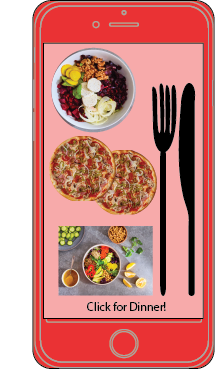Food App Delivery Sales Up
Just 5 years ago, if you wanted dinner delivered, your choices were likely pizza, Indian food, or other Asian cuisines. National pizza chains dominated the market while local restaurants offered delivery only in various neighborhoods. What started as a phone or online ordering has now become available at the touch of your phone app. According to research done by Aric Zion, et. al, Grub Hub had close to 4 million in food sales in 2017 and Uber Eats grew by 230% (1).
Why are these meal delivery services becoming so popular and who is using them?
 Experts believe that food app delivery sales are on the rise for a number of reasons. For starters, Americans love to eat but crave convenience. Those with busier lives, which may include small children, prefer the comfort of their own home. Rather than going out to restaurants, the food they desire can come to them. In young adults, aged 18 to 29, 63% of those surveyed use a delivery app compared to 51% of those between the ages of 30 and 44. In the 45 to 60-year age group, 29% used an app and in those over 60, just 14% have used food delivery apps. In addition, Zion’s research found that lower-income adults were more likely to use food delivery apps than more affluent consumers. In those earning below $10,000 per year, 51.6% used delivery apps compared to 44.6% in those earning between $10,000 to 24,900 (1).Research conducted by US Foods finds equally interesting data. According to a 2019 study, “the average person has 2 food delivery apps and uses them at least 3x per month.” More than half (54%) start with a restaurant in mind, then search for it in apps, while 46% open the app and seek out ideas. The top 4 most popular food delivery apps are (in order), Uber Eats, followed by Grubb Hub, Door Dash, and Postmates. One benefit of food delivery is the variety of food offered. People are trying different cuisine they hadn’t eaten previously (2).Another reason food delivery apps have grown in popularity is lack of cooking skills. While 80% of Millenials believe that meals should be prepared at home, only 45% are confident in their cooking skills, according to a 2015 Market Watch survey. Because many had two parents in the workforce, they didn’t have role models that were making meals themselves. In addition, home economics classes have seen a 40% reduction rate in enrollment in the past 10 years (3). Studies show that restaurant food tends to be higher in fat, calories, sodium and sugar and lower in fruits, vegetables, vitamins, minerals and fiber. It’s also linked with excessive weight gain and higher BMI (4).With the American obsession with convenience and technology, food delivery apps aren’t going away anytime soon. Dietitians can help their clients navigate healthier food options by doing the following:
Experts believe that food app delivery sales are on the rise for a number of reasons. For starters, Americans love to eat but crave convenience. Those with busier lives, which may include small children, prefer the comfort of their own home. Rather than going out to restaurants, the food they desire can come to them. In young adults, aged 18 to 29, 63% of those surveyed use a delivery app compared to 51% of those between the ages of 30 and 44. In the 45 to 60-year age group, 29% used an app and in those over 60, just 14% have used food delivery apps. In addition, Zion’s research found that lower-income adults were more likely to use food delivery apps than more affluent consumers. In those earning below $10,000 per year, 51.6% used delivery apps compared to 44.6% in those earning between $10,000 to 24,900 (1).Research conducted by US Foods finds equally interesting data. According to a 2019 study, “the average person has 2 food delivery apps and uses them at least 3x per month.” More than half (54%) start with a restaurant in mind, then search for it in apps, while 46% open the app and seek out ideas. The top 4 most popular food delivery apps are (in order), Uber Eats, followed by Grubb Hub, Door Dash, and Postmates. One benefit of food delivery is the variety of food offered. People are trying different cuisine they hadn’t eaten previously (2).Another reason food delivery apps have grown in popularity is lack of cooking skills. While 80% of Millenials believe that meals should be prepared at home, only 45% are confident in their cooking skills, according to a 2015 Market Watch survey. Because many had two parents in the workforce, they didn’t have role models that were making meals themselves. In addition, home economics classes have seen a 40% reduction rate in enrollment in the past 10 years (3). Studies show that restaurant food tends to be higher in fat, calories, sodium and sugar and lower in fruits, vegetables, vitamins, minerals and fiber. It’s also linked with excessive weight gain and higher BMI (4).With the American obsession with convenience and technology, food delivery apps aren’t going away anytime soon. Dietitians can help their clients navigate healthier food options by doing the following:
- Offer simple cooking classes. Even if your clients cook only a few meals at home, they’ll save money as well as calories and fat.
- Encourage consumers to try meal prep kits to learn basic cooking skills.
- Review which restaurants clients most often utilize and find the healthiest options.
- Offer “dietitian-approved picks” to restaurants as a service.
- Provide grocery tours and meal planning services for clients.
By Lisa Andrews, MEd, RD, LDReferences:
- https://www.zionandzion.com/research/food-delivery-apps-usage-and-demographics-winners-losers-and-laggards/
- https://www.usfoods.com/our-services/business-trends/2019-food-delivery-statistics.html
- https://blogs.wsj.com/numbers/wanted-more-home-economics-1462/
- Timothy L Barnes,1,* Simone A French,1 Nathan R Mitchell,1 and Julian Wolfson2 Fast-food consumption, diet quality and body weight: cross-sectional and prospective associations in a community sample of working adults. Public Health Nutr. 2016 Apr; 19(5): 885–892.


